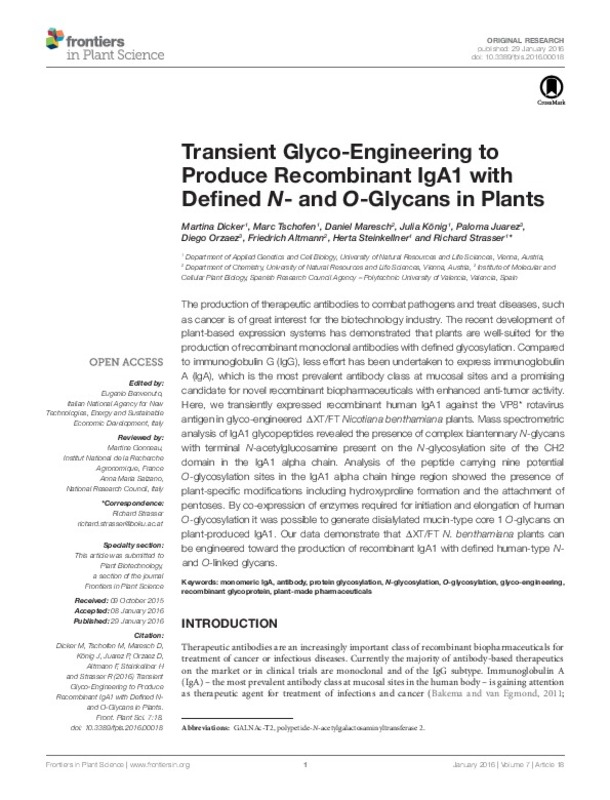JavaScript is disabled for your browser. Some features of this site may not work without it.
Buscar en RiuNet
Listar
Mi cuenta
Estadísticas
Ayuda RiuNet
Admin. UPV
Transient glyco-engineering to produce recombinant IgA1 with defined N-and O-glycans in plants
Mostrar el registro sencillo del ítem
Ficheros en el ítem
| dc.contributor.author | Dicker, Martina
|
es_ES |
| dc.contributor.author | Tschofen, Marc
|
es_ES |
| dc.contributor.author | Maresch, Daniel
|
es_ES |
| dc.contributor.author | Koenig, Julia
|
es_ES |
| dc.contributor.author | Juarez, Paloma
|
es_ES |
| dc.contributor.author | Orzáez Calatayud, Diego Vicente
|
es_ES |
| dc.contributor.author | Altmann, Friedrich
|
es_ES |
| dc.contributor.author | Steinkellner, Herta
|
es_ES |
| dc.contributor.author | Strasser, Richard
|
es_ES |
| dc.date.accessioned | 2017-05-17T12:46:18Z | |
| dc.date.available | 2017-05-17T12:46:18Z | |
| dc.date.issued | 2016-01-29 | |
| dc.identifier.issn | 1664-462X | |
| dc.identifier.uri | http://hdl.handle.net/10251/81292 | |
| dc.description.abstract | [EN] The production of therapeutic antibodies to combat pathogens and treat diseases, such as cancer is of great interest for the biotechnology industry. The recent development of plant-based expression systems has demonstrated that plants are well-suited for the production of recombinant monoclonal antibodies with defined glycosylation. Compared to immunoglobulin G (IgG), less effort has been undertaken to express immunoglobulin A (IgA), which is the most prevalent antibody class at mucosal sites and a promising candidate for novel recombinant biopharmaceuticals with enhanced anti-tumor activity. Here, we transiently expressed recombinant human IgA1 against the VP8* rotavirus antigen in glyco-engineered XT/FT Nicotiana benthamiana plants. Mass spectrometric analysis of IgA1 glycopeptides revealed the presence of complex biantennary N-glycans with terminal N-acetylglucosamine present on the N-glycosylation site of the CH2 domain in the IgA1 alpha chain. Analysis of the peptide carrying nine potential O-glycosylation sites in the IgA1 alpha chain hinge region showed the presence of plant-specific modifications including hydroxyproline formation and the attachment of pentoses. By co-expression of enzymes required for initiation and elongation of human O-glycosylation it was possible to generate disialylated mucin-type core 1 O-glycans on plant-produced IgA1. Our data demonstrate that XT/FT N. benthamiana plants can be engineered toward the production of recombinant IgA1 with defined human-type Nand O-linked glycans. | es_ES |
| dc.description.sponsorship | This work was supported by a grant from the Austrian Federal Ministry of Transport, Innovation and Technology (bmvit) and Austrian Science Fund (FWF): TRP 242-B20 and by the Austrian Research Promotion Agency (Laura Bassi Center of Expertise "Plant produced Bio-Pharmaceuticals" Grant Nr. 822757). | |
| dc.language | Inglés | es_ES |
| dc.publisher | Frontiers Media | es_ES |
| dc.relation.ispartof | Frontiers in Plant Science | es_ES |
| dc.rights | Reconocimiento (by) | es_ES |
| dc.subject | Monomeric IgA | es_ES |
| dc.subject | Antibody | es_ES |
| dc.subject | Protein glycosylation | es_ES |
| dc.subject | N-glycosylation | es_ES |
| dc.subject | O-glycosylation | es_ES |
| dc.subject | Glyco-engineering | es_ES |
| dc.subject | Recombinant glycoprotein | es_ES |
| dc.subject | Plant-made pharmaceuticals | es_ES |
| dc.subject.classification | BIOQUIMICA Y BIOLOGIA MOLECULAR | es_ES |
| dc.title | Transient glyco-engineering to produce recombinant IgA1 with defined N-and O-glycans in plants | es_ES |
| dc.type | Artículo | es_ES |
| dc.identifier.doi | 10.3389/fpls.2016.00018 | |
| dc.relation.projectID | info:eu-repo/grantAgreement/FWF//TRP 242-B20/ | es_ES |
| dc.relation.projectID | info:eu-repo/grantAgreement/FFG//822757/ | es_ES |
| dc.rights.accessRights | Abierto | es_ES |
| dc.contributor.affiliation | Universitat Politècnica de València. Instituto Universitario Mixto de Biología Molecular y Celular de Plantas - Institut Universitari Mixt de Biologia Molecular i Cel·lular de Plantes | es_ES |
| dc.description.bibliographicCitation | Dicker, M.; Tschofen, M.; Maresch, D.; Koenig, J.; Juarez, P.; Orzáez Calatayud, DV.; Altmann, F.... (2016). Transient glyco-engineering to produce recombinant IgA1 with defined N-and O-glycans in plants. Frontiers in Plant Science. 7(18):1-12. https://doi.org/10.3389/fpls.2016.00018 | es_ES |
| dc.description.accrualMethod | S | es_ES |
| dc.relation.publisherversion | http://dx.doi.org/10.3389/fpls.2016.00018 | es_ES |
| dc.description.upvformatpinicio | 1 | es_ES |
| dc.description.upvformatpfin | 12 | es_ES |
| dc.type.version | info:eu-repo/semantics/publishedVersion | es_ES |
| dc.description.volume | 7 | es_ES |
| dc.description.issue | 18 | es_ES |
| dc.relation.senia | 331818 | es_ES |
| dc.identifier.pmid | 26858738 | en_EN |
| dc.identifier.pmcid | PMC4731523 | en_EN |
| dc.contributor.funder | Bundesministerium für Verkehr, Innovation und Technologie, Austria | |
| dc.contributor.funder | Austrian Science Fund | |
| dc.contributor.funder | Österreichische Forschungsförderungsgesellschaft |








